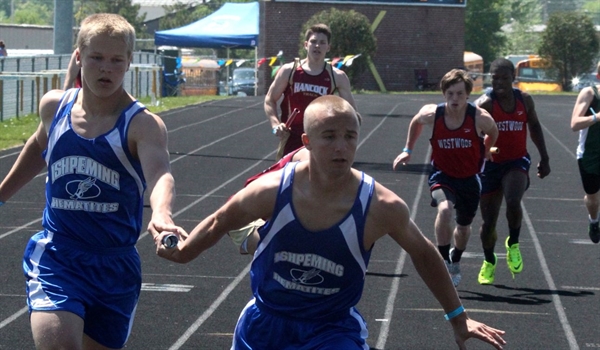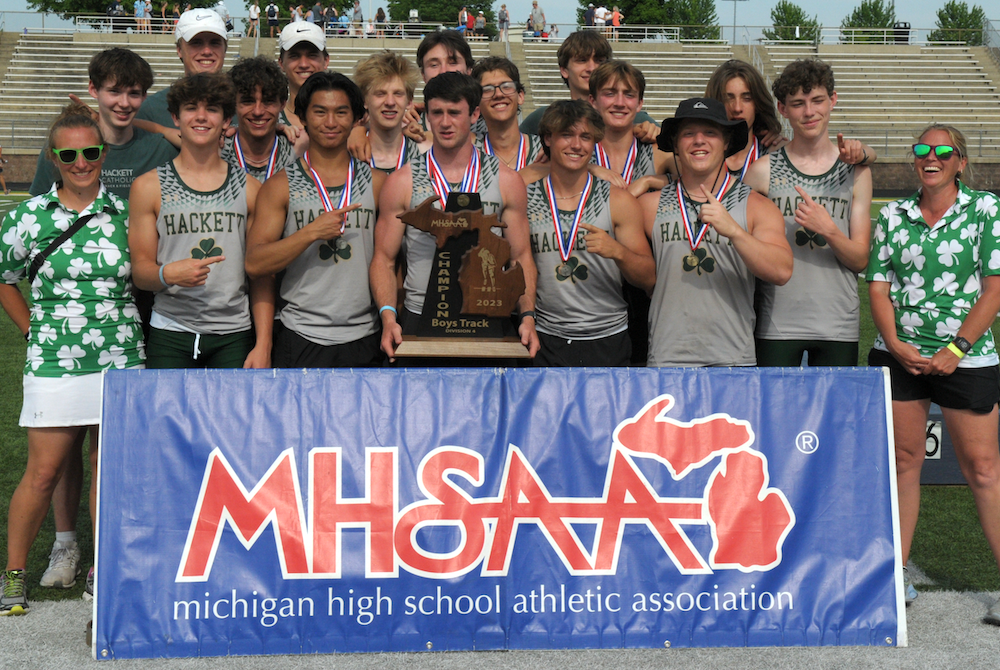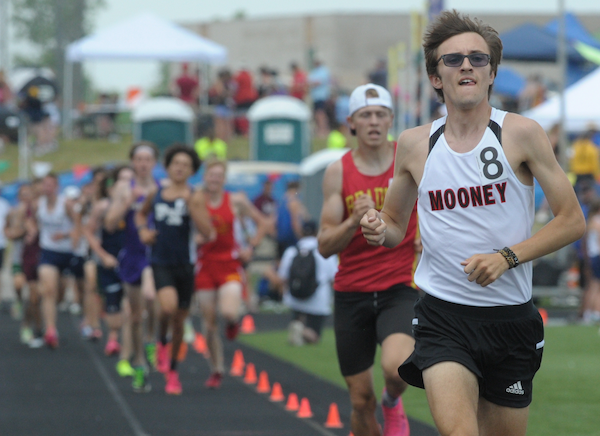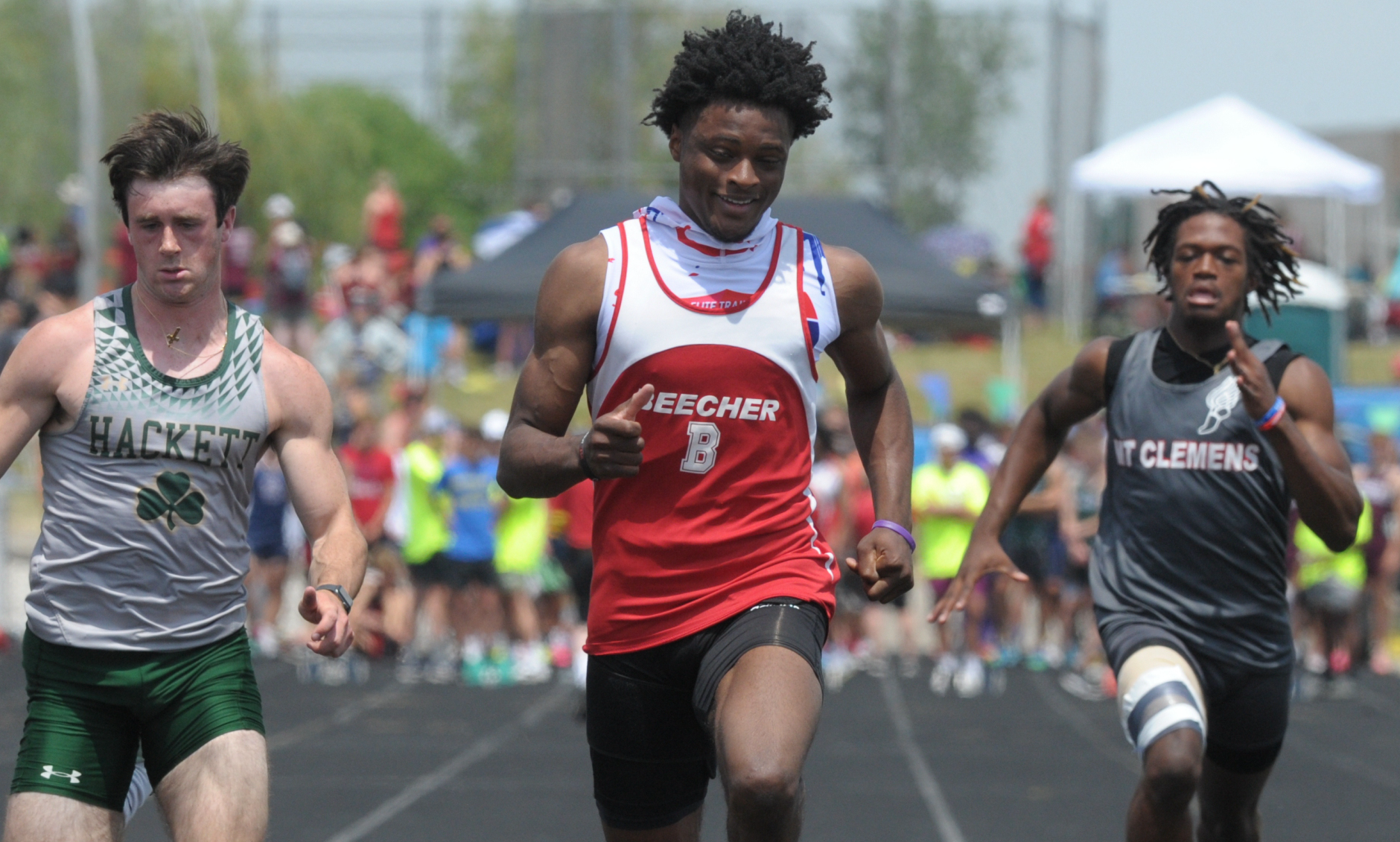
Ishpeming Steps Up to 1st in UP D2
By
John Vrancic
Special for MHSAA.com
June 1, 2014
KINGSFORD — After taking home the runner-up trophy a year ago, the Ishpeming boys track and field team took that final step up the podium in Saturday’s Upper Peninsula Division 2 Finals.
The Hematites collected 115 points, earning their first title since 2003. They were followed by defending champ Manistique with 76 and Hancock with 61.
“We looked back at the seeding times, and it looked like we were 30 points better than them,” said Ishpeming coach Scott Syrjala. “We knew Manistique was faster than that. It’s a real feather in our cap to win by nearly 40. The guys were showing up for Saturday and Sunday workouts because we had practice whenever the sun was shining.”
Ishpeming senior Noah Olgren won pole vault at 12 feet, with classmate Jordan Tousignant runner-up (11-6).
Senior teammate Bobby Zhulkie was runner-up to Newberry senior Leroy Ward-Harbaum in high jump (5-8) on a tie-breaker, and junior Tommy Potter placed second in the 800-meter run in 2 minutes, 7.23 seconds, the 1,600 (4:57.9) and helped the Hematites place second in the 3,200 relay.
Ishpeming junior Nate Meyer placed second in the 400 (53.39) and senior Adam Prisk was third (54.07). Meyer added a third in the 200 (23.73). Prisk and Meyer also helped the winning 800 and 1,600 relays.
Manistique senior Ryan Ramey retained his 400 title (51.71), but yielded his 200 crown to L’Anse senior Ryan LaBerge (23.33). Ramey was runner-up in the 200 (23.63).
Senior teammate Tony Floyd won the 100 (11.64) and took fifth in the 200 (23.83).
Hancock had double-winners in senior Jacob Jarvis and sophomore Greg Hawthorne.
Jarvis won the 110 hurdles (15.65) and 300 (40.36) and helped the Bulldogs take second in the 800 relay. Hawthorne won shot put (51-/2) and retained his discus title (142-3).
“My starts have been good all day, and my legs have gotten a little quicker in the 110s,” said Jarvis, who will study at Michigan Tech this fall. “At the Regional (at West Iron County), I felt good and started thinking (winning both U.P. hurdle races) was a realistic goal.”
Ironwood junior Jared Joki became a triple-winner, taking the 800 (2:06.58), 1,600 (4:45.18) and 3,200 in a personal-best 10:19.36.
“It’s a great feeling to win here with some amazing competition,” said Joki. “It was hot out there. I have a couple friends in D-3 and you could tell the heat drained their energy. During the races, I didn’t think the heat was much of a factor. You just had to make sure you stayed hydrated.
“I had a lower body injury during the winter, otherwise I would have tried to go under 10 (in the 3,200). Overall, I’m pleased with the whole day.”
PHOTO: A pair of Ishpeming runners exchange the baton en route to winning the 1,600 relay at the U.P. Division 2 Final on Saturday at Kingsford. (Click to see more from RunMichigan.com.)

Thrower Claims Lone Individual Title to Lead Hackett to Team 3-Peat
By
Tom Lang
Special for MHSAA.com
June 3, 2023
Kalamazoo Hackett Catholic Prep just keeps winning and winning.
This time the Irish took home their fourth title in the last five Lower Peninsula Division 4 Track & Field Finals, on Saturday at Hudsonville.
Hackett’s only individual title was taken by discus winner Nathan Buchmann, a senior, who was fine knowing he was the shortest in stature among all the sizable competitors.
“In the offseason after football I worked out every day, working towards this goal,” he said after getting his medal. “I would say this takes 80 percent technique and 20 percent strength to throw the discus. So, length can help but if you have good technique and are really strong, that will play into it.
“I think we are very balanced throughout the meet today,” he said about teammates that scored points in finishes other than first place. “We have 13 guys here today, and we have people in a lot of the races. But I do not run; I have too short of legs to be a fast runner,” he said with a chuckle.
Buchmann had to work through a hip injury to compete this spring.
“I think the setbacks are what make you strong,” he said. “You can either give up through the setbacks or push forward and become better.”
 Coach Charissa Dean agreed.
Coach Charissa Dean agreed.
“The kids have big hearts,” she said after all the points were totaled and the Irish were on top once again, with 53. “They worked hard. They had a lot of potential when we started the season. And we had a lot of drive to put in the work, and we are happy the results came out the way they did.”
Reading was runner-up at 47 points, followed by Wyoming Potter’s House Christian with 42, then Fowler and Flint Beecher each with 37 points.
Senior Lezawe “Moses” Osterink, of Potter’s House Christian, placed second in 1,600 but took the 3,200 title as defending champ of both. He dominated the latter by lapping the field with a final lap kick that resembled more of a superhero speedster.
“Nobody really took it out that hard at the start,” he said. “There was a freshman (Marek Butkiewicz of Hackett) that tried to get the pace going quick, but me and Dakota (Dykhuis of Montabella) just kind of sat back and gradually pulled him through.
“We took it gradually, and I was just relying that I could kick.”
Kick did he ever. The trio were neck and neck the majority of the race in a grouping ahead of the pack.
“With 400 to go I just tried to go all out,” Osterink said. “I had a lot more left than I thought and I was pleased with the win. Not really the time, but that doesn’t matter, especially this hot out.”
The overall meet was in the low 90s/high 80s heat and searing sun all day. So, race officials allowed the unique opportunity for coaches to spray the runners with water and give them water bottles.
“It was very weird because I’ve never taken water to drink while I’m running, so I didn’t know how that would feel,” Osterink said. “And they were spraying us and hitting us in the face. It was kind of fun.”
Junior Tyler Lenn of Marine City Cardinal Mooney defeated Osterink at his own game in the 1,600.
“I’m feeling great,” Lenn said after grabbing the medal. “I said to a newspaper after one of my races (during the season) I was right where I wanted to be. This has been a long rebuilding process for me since an injury back in the fall, and I set a pretty high goal the day the injury happened. I was telling myself I needed to fulfill what I said I would do at the beginning of last cross country season. And that is what I did today.”
Lenn suffered an ankle sprain from a misstep that turned worse because he kept running through the season on it.
“Coming back from that was pretty tough, but I wouldn’t have it any other way,” he said.  “Perseverance; I said from the beginning what I was going to do. I kept my eye on that target, and no matter the circumstances life threw at me, that I was going to make it happen and I am a man of my word.”
“Perseverance; I said from the beginning what I was going to do. I kept my eye on that target, and no matter the circumstances life threw at me, that I was going to make it happen and I am a man of my word.”
Jaylin Townsend, a senior from Flint Beecher, dominated the short races. He won the 100 dash (10.67) and 200 dash at 22 seconds flat. It was his third 100 win at a Finals.
“I put in a lot of work; I had to three-peat,” he said after the 100. “There’s a lot of great competition here, so I knew I had to come out and run my best.”
Concord in the 400 (43.72), Buckley in the 800 (1:30.76) and 1,600 (3:29.13) and Potter’s House in the 3,200 (8:14.18) were relay champs Saturday. Reading’s Tayshawn Bester won the 110 hurdles (15.13), and Athens’ Landen Bennett won the 300 (39.85). Caseville’s Nathan Feltner won the 400 (50.76), and Vestaburg’s Owen Patton claimed the 800 (1:55.11).
Fruitport Calvary Christian’s Bradley Richards won the high jump (6-10), and Peck’s Alex Affer won the long jump (23-4). McBain Northern Michigan Christian’s Isaac Bowden was first in pole vault (13-0), and Brown City’s Kyle Affer won shot put (49-2).
PHOTOS (Top) Kalamazoo Hackett Catholic Prep celebrates its third-straight LPD4 title Saturday. (Middle) Cardinal Mooney's Tyler Lenn, far right, sets the pace in the 1,600. (Below) Flint Beecher's Jaylin Townsend, middle, crosses the finish first for one of his two sprint championships. (Photos by Ken Swart/RunMichigan.com.)

